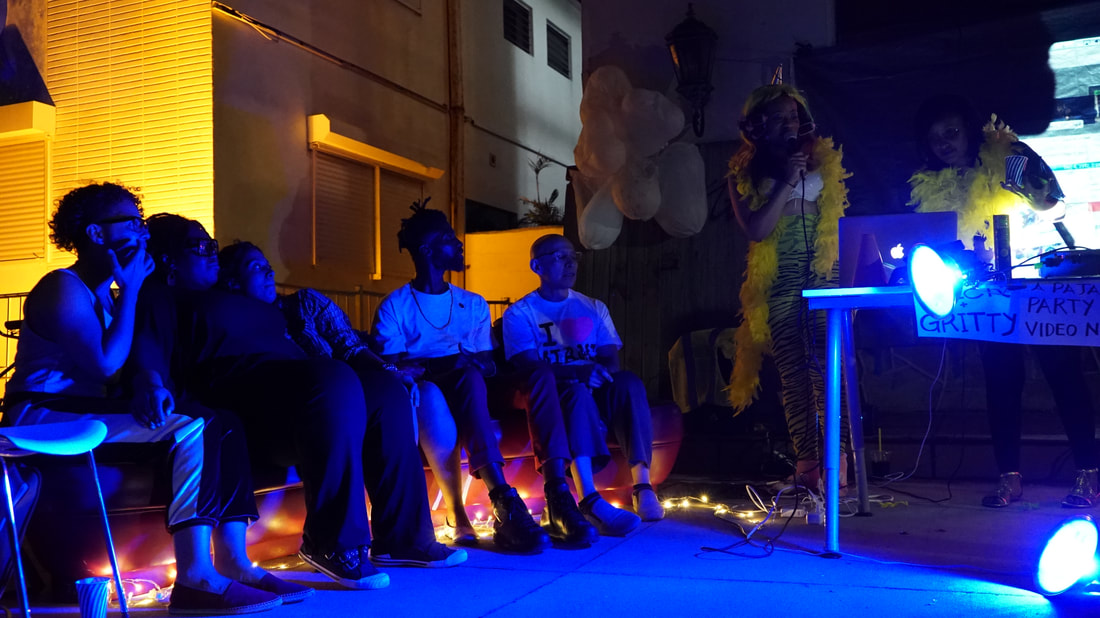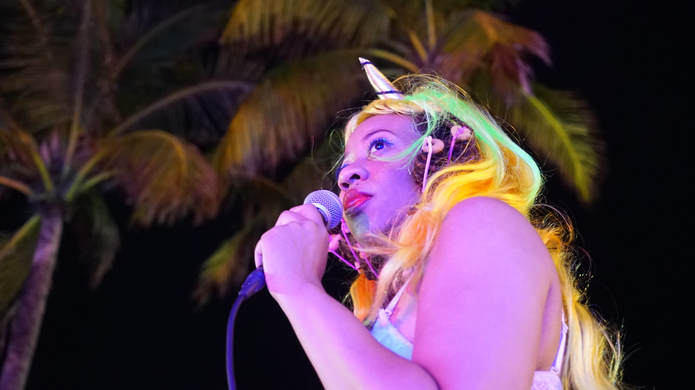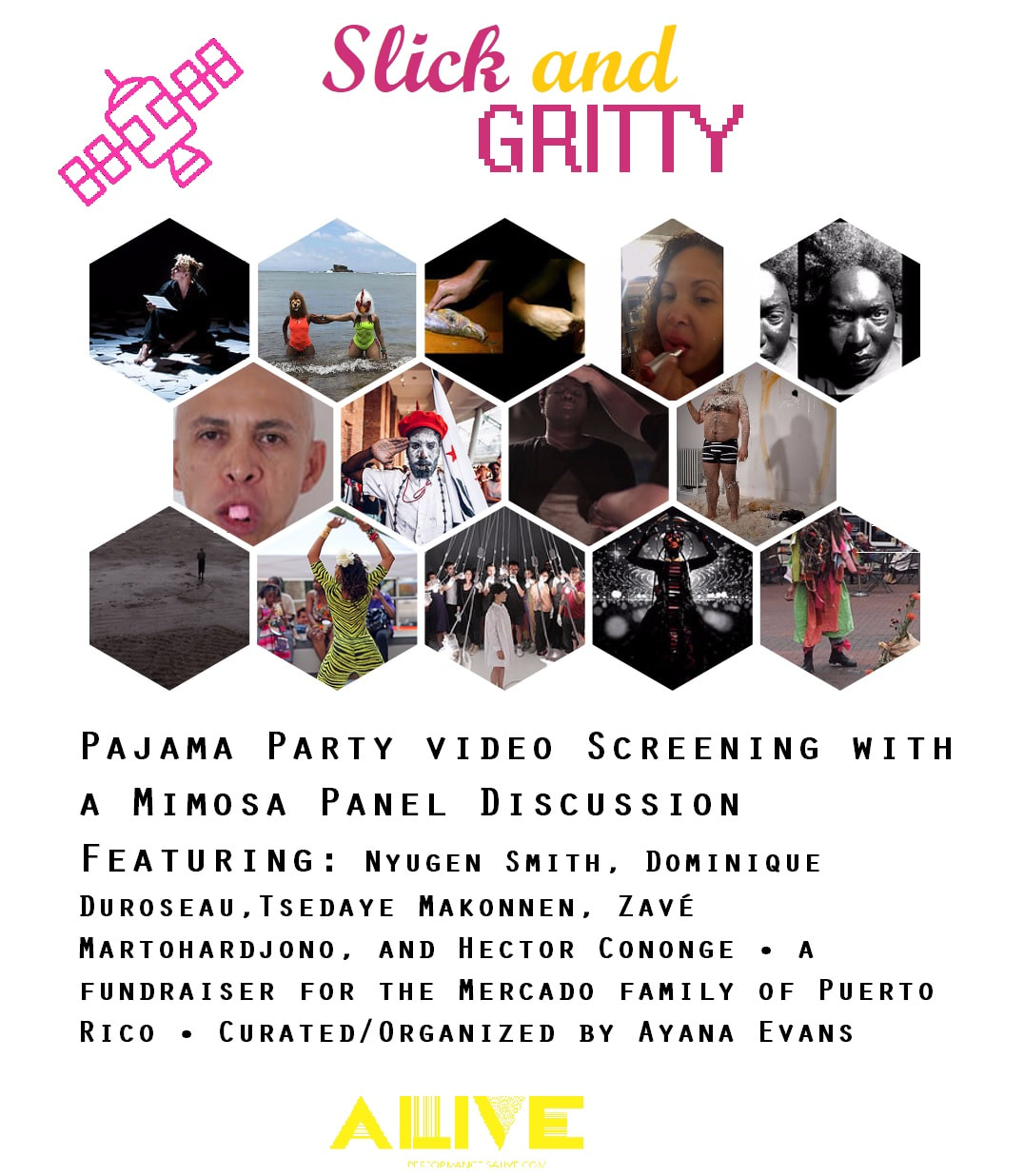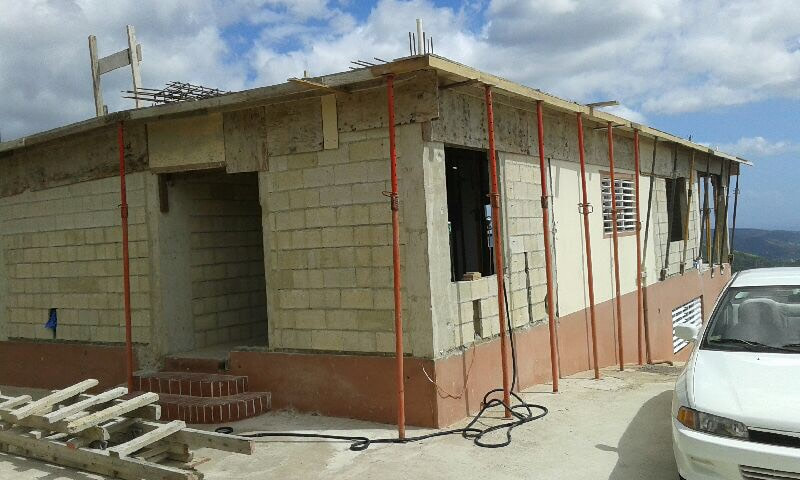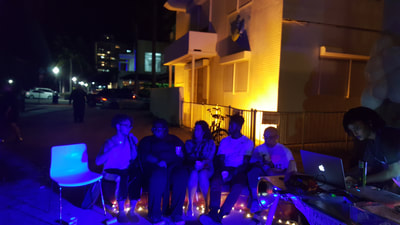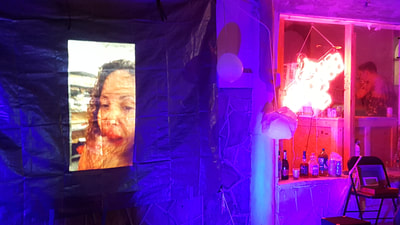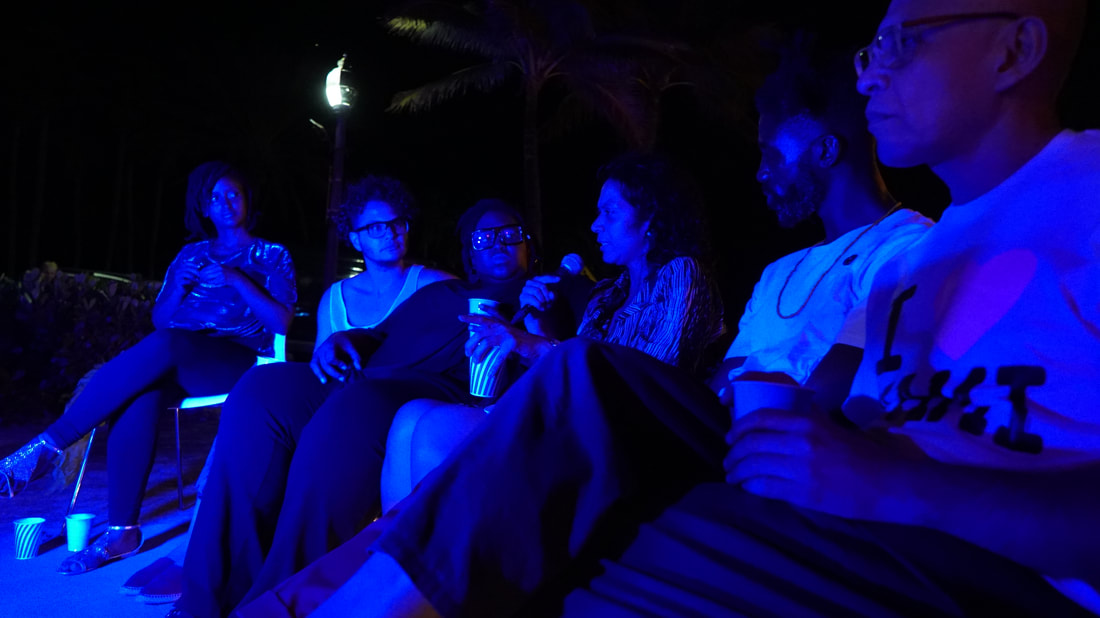|
Last December #AliveAtSatellite artist, Ayana Evans, presented "Slick and Gritty" - a video screening and panel discussion organized to benefit Geraldo Mercado's family members who fell victim to the disastrous path of Hurricane Maria. The family farm was destroyed and US aid was minimal in their rural area of Sierra Alta. Geraldo's grandparents, Ruder and Brunilda Caraballo, as well as his great-aunts Rosa Sanchez and Catalina Sanchez, struggled to replace the roof on their homes. The initial fundraising goal for Slick and Gritty was successfully surpassed per the tireless promotion and advocacy of Evans. The family has been busy with repairs and I thought it would be a perfect time to re-connect with Ayana and Geraldo for updates and event reflections. There is still much work to be done in Puerto Rico, please consider donating to the Viajero Hurricane Relief Fund. QUINN DUKES: Now that a few months have passed, how do you feel about running such an ambitious program at Satellite Art Show? AYANA EVANS: Hahaha... I think I was crazy to think it would be easy! But I am extremely proud of coming up with the idea and very happy that we pulled it off! Doing that with very little funding felt like a miracle, but luckily people in our community (Ahem - like yourself, Tsedaye Makonnen, Elizabeth Lamb, Dom Duroseau, Cynthia Post Hunt, Zave Martohardjono, Brian McKorkle...etc!!) are willing to lend their sweat equity for a good cause! I also think that it gave me a lot more respect for organizers like yourself, Quinn. You do Slick and Gritty times 10 every year with very little budget. That is a feat to be reckoned with. It made me want it do more programming like this in the future. The challenge of it all was energizing. Only doing solo performances is not as impactful on the lives of others. QD: Ohh, thanks so much for your kind words Ayana. It is my great privilege to provide this platform for performance art during Miami Art Basel. QD: What led you to select the artists and panelists for Slick and Gritty? AE: The artists are literally my version of a dream team for video art. They are all people who I wanted to see at one night of screenings and they all make work that I truly respect and enjoy. Because the selection is diverse and their subject matters vary, it is unlikely that the artists I chose would ever be curated together in this manner for a gallery screening during Basel. At Basel people are often shown with other people discussing similar subject matter or shown based on race or gender. I also didn’t pick according to “artist buzz,” which definitely happens a lot during Miami Basel. I understand that happens because people are trying to make money. I don’t knock anyone for that, but it didn’t fit with my vision. Plus with the exception of two people in the show, we all knew Geraldo! So it all boils back to helping a friend. I think as performance artists, we tend to be the most under paid on the art food chain (sometimes on purpose - but that's another interview!) When you do not have a lot monetarily and a disaster like the one in Puerto Rico happens you feel a little helpless. Most of us can’t afford to take off from work and go there to physically help and at the same time we can’t afford to send more than a few dollars. I thought using our art and crowdfunding would be a way to help a little bit more than I could by myself. Focusing on someone I know who still has close relatives on the island felt like the way we could all help. Making it a Pajama Party with a Mimosa Panel discussion (that included a little whiskey) just added to the good vibes and fun! QD: Do you have experience organizing fundraisers? Is this something that you feel is a part of your practice? AE: I have experience with crowdfunding online, but none with organizing fundraisers, so I wouldn’t say it’s part of my practice. In fact, I am always thinking, “I can’t wait for the day that I do not have to crowd fund,” because completing a successful crowdfunding campaign online is a hard thing for me to do! To be successful at one, it has to be seen as a job. One has to post updates, keep asking for money daily, post in clever ways - on different platforms, and make a lot of personal phone calls/texts, while still working the usual day job(s) and in my case also doing regularly scheduled performances. I did that on a lesser scale for Slick and Gritty because the in-person fundraiser event offset some of the need to beg online, but most of the donations were still from online contributions. I feel like I'm complaining too much. - Let me say that although it requires a lot of work, I do champion crowdfunding as a tool! I basically have an art career because of a push from Kickstarter. That campaign raised enough for me to do several performance art pieces that never would have happened otherwise. That crowdfunding campaign 6 years ago taught me A LOT. I didn’t realize how many people were in my corner and wanted to help me push my art forward. Since then I have done a several other crowdfunding projects that were successful. I am very grateful for that. QD: What drew you to raise funds for the Mercado family? AE: Geraldo Mercado is my friend. It’s really as simple as that. I saw a couple posts where he said his grandmother and aunts were alive but everything wasn’t ok. When you see posts like that on FB or whatever platform you should do what you can for your friend. I think artists often make work about the problems of the world, but I think it is equally important (maybe even more important) to make art and artistic programming that helps alleviate the problems somehow. Also, there is the issue of not always knowing if your small donation for hurricane relief will ever reach the people who need it. I knew Geraldo would make sure his family got every penny we sent them. QUINN DUKES: Your work was featured as a part of Slick and Gritty, can you talk a bit about the video that was featured? GERALDO MERCADO: The main focus of my artistic practice has been performance art since 2012, though I’ve been passionate about making video art ever since I saw the movie Night of the Living Dead about 18 years ago. Most of my video art has been an exercise in trying to tell stories without using any sort of traditional narrative structure, and the outcome typically ends up looking more like a moving abstract painting than anything else. At Slick N’ Gritty, I exhibited a 10-minute excerpt from Untitled Human Flourishing Project, a 30-minute piece created for the noise music duo Human Flourishing (Gregory Paul and Connor Perreault). The entire piece consists of swirling vortexes and demonic hellscapes created by compositing dozens and dozens of layers of original and found footage on top of each other after they’ve been manipulated and altered. The whole thing took about two weeks to just render the final product. The entire piece is devoid of sound as it was designed to have Human Flourishing play a live, improvised score over the footage when its exhibited. As I’ve aimed to make the message behind my performances more transparent, I’d love to take a crack at making a more traditional video piece in the near future. I make fewer videos than I do performances, but videos typically take on a life of their own and get exhibited at several locations, while performances only exist in one place at one moment. This had been my latest video when Ayana reached out to me, and we both decided it would be a great fit for the show. QD: How is your family in Puerto Rico doing today? GM: I’m happy to report that my family in Puerto Rico is doing much better now! Everyone is alive and well and in good spirits. Seeing photos on social media of my uncle’s medical lab being open for business again has been such a joy. Even seeing my cousins posting about memes, music, art, basically anything besides the hurricane, has been such a relief. QD: When did you see this shift? GM: We first heard from my family on September 26th, about 10 days after the Hurricane hit. We weren’t able to hear from them regularly until at least a month and a half to two months after that. We really are the lucky ones, as there are still parts of the island that are difficult to reach. QD: What have been the main challenges that your family has experienced? GM: Yauco, where I’m from, is in the southern part of the island and wasn’t hit as hard by Hurricane Maria, though a lot of devastation still occurred there. My family is mostly dealing with property damage and loss of power, the funds from Slick n Gritty went to my great aunt whose house was completely destroyed. She was overjoyed to hear about the fundraiser and that we had collected over $900 for her. Relief came slowly in Yauco, which made it very difficult for those of us in the mainland who were waiting to hear some (hopefully) good news. When people started making contact with their loved ones before us, it was hard to not think the worst. When my Mom in Massachusetts texted me saying that one of my cousins in Yauco was able to send her a brief message on Whatsapp, I breathed a huge sigh of relief. I’ve been able to communicate with my great aunt via text which has been excellent. Besides being able to get updates on how the repairs on her home have been going, the fundraiser has brought the two of us closer together since we have been communicating much more frequently now. QD: Have you been able to visit your family’s farm? GM: I haven’t been able to visit my family in Puerto Rico yet, my partner and I had plans to go last fall which were curtailed by Hurricane Maria. Unfortunately, I don’t get to visit Puerto Rico as often as I’d like. My last time there was winter 2015, and the time before was 2006. That 2015 trip was magical, I got to be there for my grandfather’s 80th birthday which came as a total surprise to him and my grandmother. It felt like I had never left. I have plans to visit PR later this year for my cousin’s wedding which I’m very excited about. I would love to visit my family before then, though I feel like whatever money I raise for plane tickets would be better served helping the recovery effort until then. QD: What still needs to be done for hurricane victims in PR? GM: It’s been over five months since Hurricane Maria hit the island and 28% of Puerto Ricans remain without power. There are still so many people left without homes or even access to proper medical care. Officials can’t even agree on the actual death toll of the hurricane, though I believe it has hovered around 64 since December, with many deaths going unreported. There are many worthwhile charitable organizations still collecting money to help those on the island, and I would encourage everyone to donate to them or help spread the word. You can see a list of organizations at losambulantes.com/help-puerto-rico/. I would recommend donating to ‘Defend Puerto Rico Hurricane Relief Fund’ at youcaring.com/defendprhurricanerelieffund-955117. QD: Has any assistance been offered by the US government? GM: Even before Hurricane Maria, the US government has always treated Puerto Rico as an afterthought. Bad corporate deals, lack of federal funding when compared to the States, and strange tax policies were allowed to plunge the island into incredible amounts of debt. The island’s infrastructure had been in dire need of upkeep for years, which is making it extra difficult to repair it now after the hurricane. On top of that, this couldn’t have happened during a worse administration. Trump and his staff completely dropped the ball when it came to offering proper support. That image of him chucking paper towels at victims is downright dehumanizing. This isn’t surprising given what we know of Trump’s opinion of the Latinx community. Relief efforts following Hurricane Katrina were famously mishandled by the Bush administration, but this administration has done drastically worse following Maria. In February, Senate leaders approved more funding for Puerto Rico’s relief efforts, including $4.8 billion to replenish Medicaid funds and $2 billion to repair the failing power grid and hopefully restore power to the remaining areas of Puerto Rico. That said, this still falls incredibly short of what Puerto Rico’s government was asking for and even shorter of what it actually needs. QD: Do you feel that art has the potential to provide support to hurricane victims? GM: Art has the incredible power to influence, to change hearts and minds, to educate, and to create communities. All these things offer some form of relief, not just to hurricane victims, but to people experiencing many forms of trauma and tragedy. slick and gritty |
CONTRIBUTORSIan Deleón Archives
July 2023
|
|
MISSION // Based in Brooklyn, NYC, PERFORMANCE IS ALIVE is an online platform featuring the work and words of current performance art practitioners. Through interviews, reviews, artists features, sponsorship and curatorial projects, we aim to support the performance community while offering an access point to the performance curious.
Performance Is Alive is a fiscally sponsored project of Fractured Atlas, a 501(c)(3) charity. Contributions made payable to Fractured Atlas for the purposes of Performance Is Alive are tax-deductible to the extent permitted by law. |
